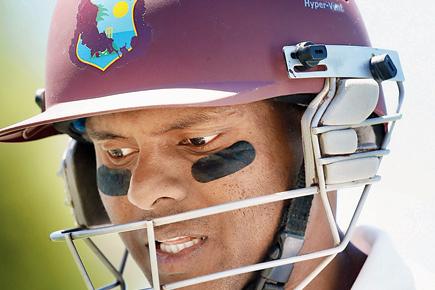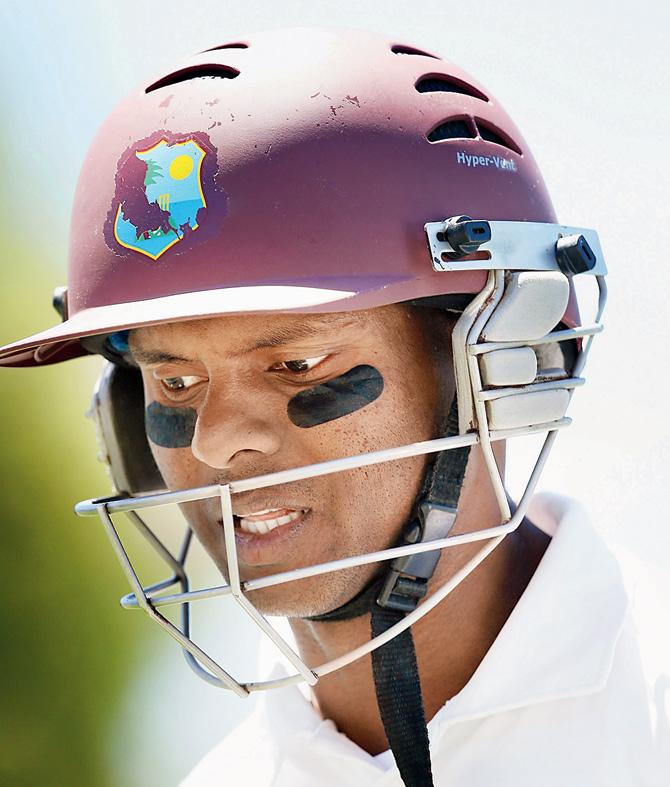It can be demoralising for a player like Shivnarine Chanderpaul to be informed that he is no longer considered worthy of a place in the team in which he was an automatic choice throughout his career, writes Tony Cozier

Shivnarine Chanderpaul
It is always distressing to observe the decline of a champion in any sport. It can be especially demoralising for a player advised that he is no longer merits a place in a team in which he had been an essential and automatic choice for most of his career.
ADVERTISEMENT

Shivnarine Chanderpaul. Pic/Getty Images
So it is with Shivnarine Chanderpaul whose sudden and unprecedented slump over two recent, successive series led the West Indies’ selectors to omit him from the two forthcoming Tests against Australia, effectively ending a remarkable career dating back 21 years.
His 11 innings in three Tests each against South Africa in South Africa in December and January and England in the Caribbean more recently yielded 183 runs at an average of 16.63.
Such statistics were unprecedented for a batsman of exceptional consistency; they were not misleading. The slim left-hander, previously an immovable object for the world’s bowlers, was just a shadow of the rock upon which West Indies’ fragile batting relied as they plummeted from 15 years of Test domination to virtual irrelevance.
Into his 41st year, age, the enemy of those reliant on keen eyesight and quick reflexes, was unavoidably blamed.
Chief selector Clive Lloyd, a fellow Guyanese and himself an icon of West Indies cricket, redundantly described Chanderpaul’s exclusion as “a tough decision to make”.
“We felt that the time had come to look towards younger players,” he explained. It was a policy created by the emergence over the past year of Kraigg Brathwaite, Jermaine Blackwood and Jason Holder, all in their early 20s, and the return to form of Darren Bravo, 26, following the “personal problems” that caused him to twice withdraw from tours.
The issue triggered an immediate and widespread outcry.
No ordinary cricketer
Chanderpaul, after all, was no ordinary cricketer. His unassuming personality and meticulous accumulation of runs contrast markedly with the flamboyant West Indian stereotype yet he has more Tests (164) than any other and is second only to Brian Lara in runs scored (11,684 to 11,912) and hundreds hit (30 against 34).
Reflecting the general anger at the imposed demise of such a player, Lara countered some opinion that Chanderpaul should have had the chance solely to overtake his own high water mark as the West Indies leading scorer.
“It has absolutely nothing to do with runs or numbers,” the legendary left-hander, a teammate through Chanderpaul’s first 13 years of Test cricket, said. “It has to do with respect and Chanderpaul has earned the right to say goodbye in an acceptable way. He should be allowed to do it in his own way.”
“The West Indies Cricket Board (WICB) and the Caribbean owe it to Shiv to send him off with dignity and respect. He has earned it,” he added.
Lara compared the way the BCCI organised a Test series, ironically against West Indies, that accorded Sachin Tendulkar “a farewell in keeping with his contribution to the game” with Chanderpaul’s “shabby treatment”.
Chanderpaul himself contended that he should not be “pushed into retirement”. Alerted to the selectors’ intentions after the final Test against England, he told new head coach Phil Simmons that the Australia Tests would be his opportunity “to acknowledge my supporters at home, and the possibility of the WICB properly honoring me for my contribution to West Indies cricket”.
Shiv makes his point
When Simmons replied that retirement was a better option than being dropped, Chanderpaul responded with the defiance on which his batting has been based: “I have decided to make myself available for the Australian series. I am not retiring.”
Indeed, those close to him revealed that he intended to carry on for Guyana into the 2015-16 regional first-class season that starts in November. A glut of runs would further complicate the situation.
Since he first shuffled to the middle at his home ground of Bourda in seemingly oversized pads for his Test debut
against England in 1994, Chanderpaul shared dressing rooms with 106 West Indies players to whom he became the veritable godfather.
He was led by 12 captains, from Richie Richardson to Denesh Ramdin; he had a stint of 14 Tests himself before lack of support from teammates and management in a series in Australia in 2005 caused him to pack it in and rejoin the ranks.
Just six months before his omission, the left-hander with the identifiable idiosyncrasies of repeated fidgets before taking up his uniquely exaggerated front-on stance, could not be shifted by exasperated Bangladeshi bowlers who toiled in vain for 558 balls over 12 hours while he helped himself to 270 runs in two Tests in the Caribbean.
It was a repeat of earlier marathons. Against India the Caribbean in 2002, he went just over 25 hours between dismissals; the gap on three other occasions was over 17 hours.
His recent struggles against South Africa and England lowered his Test average to 51.37, still a formidable figure. There it will now remain.
A pall of controversy
All along, he set standards of commitment and discipline for others to follow. Not all did. It was a background the WICB officially asked Lloyd’s panel to consider in their selection for the Australia Tests; it drew hundreds of similar pleas on internet blogs. The selectors had already come to their decision and were not for changing.
The squabble creates a pall of controversy West Indies could do without for a series against the powerful Aussies. More to the point, it leaves a huge responsibility on Lloyd’s younger brigade to plug a gaping void.
Tony Cozier continues to be the voice of West Indies cricket
 Subscribe today by clicking the link and stay updated with the latest news!" Click here!
Subscribe today by clicking the link and stay updated with the latest news!" Click here!






